 The temperatures are hopefully trending downward, and you’re thinking about redoing your summer plantings. There seem to be so many choices; it’s normal to feel overwhelmed at the garden shop, even though you probably thought you had it all figured out before you left home!
The temperatures are hopefully trending downward, and you’re thinking about redoing your summer plantings. There seem to be so many choices; it’s normal to feel overwhelmed at the garden shop, even though you probably thought you had it all figured out before you left home!
I’ve seen the slightly dazed look on folks’ faces as they peruse the tables upon tables of pansies, violas, snapdragons, various herbs and ornamental greens. Invariably they turn to us with a bewildered look and say, “I have (insert number of pots here) and need to fill them. Can you help me?!”
Assuming you have at least a half days worth of sun for flowers, the usual pansies and violas will work just fine all on their own if you really don’t want to do a whole lot of thinking; but there’s so much more out there to play with! From the simplest addition of beautiful green curly parsley (It adds such great color and texture to a planting.) to a more complex mix of greens, grasses and herbs, there’s no limit to fun combinations.
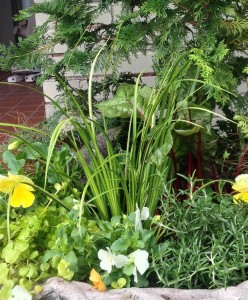 The large planter here is one of a pair, used at the top of stairs leading onto a wide open porch. I took my color cues from the red brick and cream color of the house in choosing my plants, using predominantly yellow with the evergreen Chamaecyparis ‘Crippsii’, yellow variegated Acorus ‘Ogon’, golden creeping Jenny to trail, and Matrix ‘Lemon’ pansies. To this I added ornamental red mustard, and a chard with red stems called ‘Charlotte’. These will add big, bold leaves, beautiful foliage color, and added height.
The large planter here is one of a pair, used at the top of stairs leading onto a wide open porch. I took my color cues from the red brick and cream color of the house in choosing my plants, using predominantly yellow with the evergreen Chamaecyparis ‘Crippsii’, yellow variegated Acorus ‘Ogon’, golden creeping Jenny to trail, and Matrix ‘Lemon’ pansies. To this I added ornamental red mustard, and a chard with red stems called ‘Charlotte’. These will add big, bold leaves, beautiful foliage color, and added height.
Next, more flowers with a trailing white pansy called Cool Wave White, a few orange violas and a trailing rosemary – the brown grass trailing off to one side and tucked in the back as well is Carex ‘Toffee’. When the sun shines on this grass it glows!
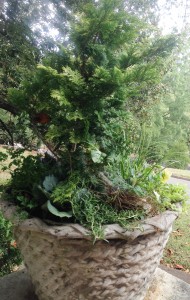 These planters are quite large and can support this variety of plants. In smaller planters, a smaller shrub, some curly parsley, pansies and a trailing plant might be sufficient. Remember, more is always better in planters and windowboxes to give them a lush overflowing feel.These planters will make a definite statement as they grow out.
These planters are quite large and can support this variety of plants. In smaller planters, a smaller shrub, some curly parsley, pansies and a trailing plant might be sufficient. Remember, more is always better in planters and windowboxes to give them a lush overflowing feel.These planters will make a definite statement as they grow out.
-
Tips For Maintaining Your Fall/Winter Planters:
- – As always, keep faded blooms deadheaded.
– Don’t overwater. As the weather cools in the fall and winter, it’s best to let planters go a bit drier.
– If plants like ornamental cabbage and parsley do get dry between watering, you’ll have some yellow leaves. Groom these and other plants regularly, removing any yellowing leaves that you see. Remember, they’re not going to turn green again!
– Watch the weather and be prepared to cover your planters if freezing temperatures are forecast. Prior to covering, water them thoroughly. Uncover them as soon as the temperatures are above freezing.
Some Interesting Choices To Use With Pansies And Violas In Winter Planters:
- Chamaecyparis obtusa – various selections; they make excellent evergreen accents.
- Cupressus ‘Carolina Sapphire’ – beautiful blue evergreen, good in the landscape also.
- Rosemary – large evergreen herb, upright or trailing varieties.
- Juniper – ‘Blue Point’
- Thuja – ‘Golden Globe’ arborvitae, nice, rounded form.
- Heuchera & Heucherella selections – evergreen perennials, interesting as a foliage element – airy blooms in spring.
- Acorus – adds another texture to plantings; grasslike variegated leaves add color as well.
- Ornamental Kale – ‘Redbor’ and ‘Winterbor’ are two very upright growing forms of kale, but there are many others. ‘Red Russian’ and ‘Lacinato’ are also edible. In a normal to mild winter they’ll last til spring. As heat returns, they’ll “bolt”, or bloom, adding yellow flowers.
- Ornamental Mustard – These add a bold leaf and a darker color to compositions.
- Chard – another beautiful and edible addition to containers or garden beds.
- Curly Parsley – Adds texture in winter plantings; also a beautiful shade of deep, clean green.
- Golden Creeping Jenny – A useful trailing element, it may get knocked back in a freeze but adds color until then and will come back as temperatures moderate.
- Muehlenbeckia, Angel Vine – tough as nails trailer. Will lose it’s leaves in a freeze but normally reappears in the spring. Protect it and it will be green through the winter in Birmingham.
- Sweet Alyssum – not available for long in fall, but a nice addition to planters until it succumbs to freezing temperatures.
- Poppies – available through the fall; worth trying if you haven’t. They hunker down through the winter but will fill out in the spring, adding their bright, papery blooms to liven any planting. Take care to not overwater under cool winter conditions.


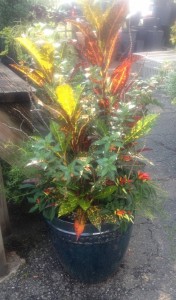

 But “What colorful foliage?”, you’re thinking by now. So glad you asked! What we have in mind are the brightly patterned leaves of crotons. Up to now you might have thought of them as simply a pretty houseplant for bright spots in your home.
But “What colorful foliage?”, you’re thinking by now. So glad you asked! What we have in mind are the brightly patterned leaves of crotons. Up to now you might have thought of them as simply a pretty houseplant for bright spots in your home.

 The best thing about crotons is that their coloration becomes more pronounced with plenty of sun, which is what the marigolds and other plants listed above prefer. Finally, surround your planting with pumpkins and gourds (or tuck a few into the base of your planting) to create a festive tableau for fall…perfect!
The best thing about crotons is that their coloration becomes more pronounced with plenty of sun, which is what the marigolds and other plants listed above prefer. Finally, surround your planting with pumpkins and gourds (or tuck a few into the base of your planting) to create a festive tableau for fall…perfect!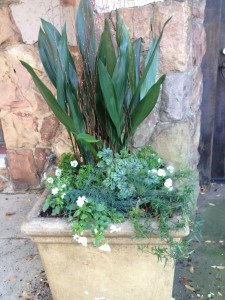
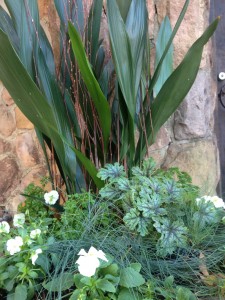 The emphasis is on foliage, though, and I’ve included curly parsley for it’s fresh green color, a small blue fescue grass, and a shade loving heuchera for this planting. Holdovers from the summer are aspidistra, which I thin out each season, and a tiny leaf green ivy. After planting, I added birch branches to add more height and winter interest. (Branches are an easy way to get color in planters during the holiday – red twig dogwood branches would also be pretty.) While it looks a bit top heavy with the tall aspidistra at first, the parsley and heuchera will add fullness to the composition as it grows in. I’m also trying the Cool Wave white trailing pansies here this year, hoping they get enough sun to bloom well.
The emphasis is on foliage, though, and I’ve included curly parsley for it’s fresh green color, a small blue fescue grass, and a shade loving heuchera for this planting. Holdovers from the summer are aspidistra, which I thin out each season, and a tiny leaf green ivy. After planting, I added birch branches to add more height and winter interest. (Branches are an easy way to get color in planters during the holiday – red twig dogwood branches would also be pretty.) While it looks a bit top heavy with the tall aspidistra at first, the parsley and heuchera will add fullness to the composition as it grows in. I’m also trying the Cool Wave white trailing pansies here this year, hoping they get enough sun to bloom well.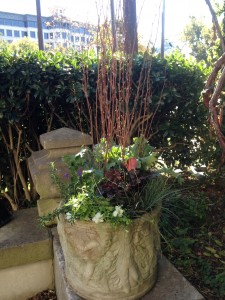
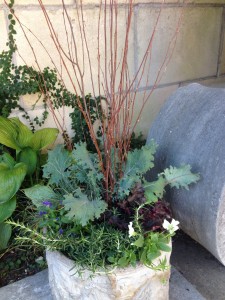 This fall Pardis asked if I would also take a look at the planters at Bottega, their other wonderful restaurant.
This fall Pardis asked if I would also take a look at the planters at Bottega, their other wonderful restaurant.